罗宾斯管理学双语教学讲稿7
- 格式:doc
- 大小:44.50 KB
- 文档页数:5
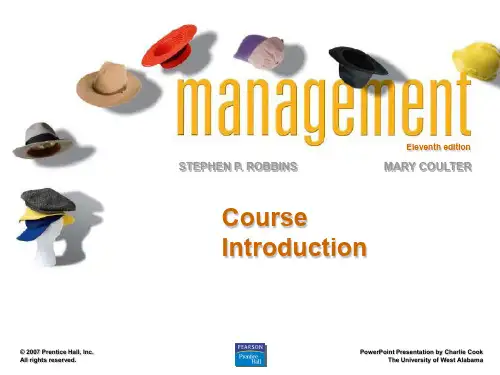

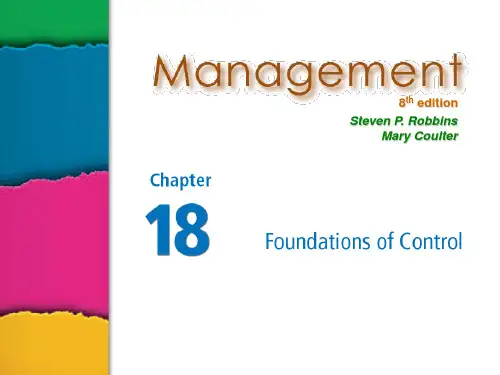
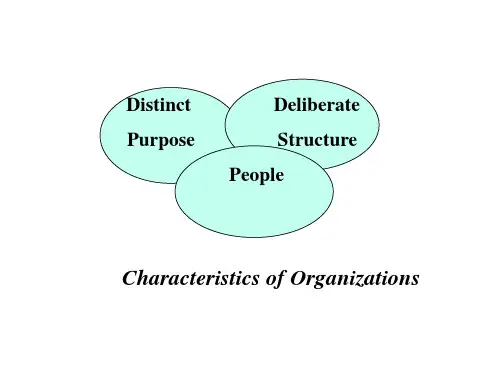
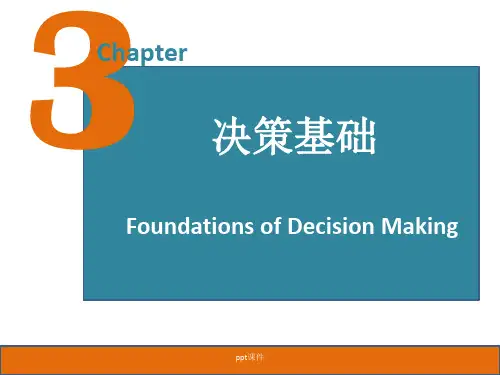
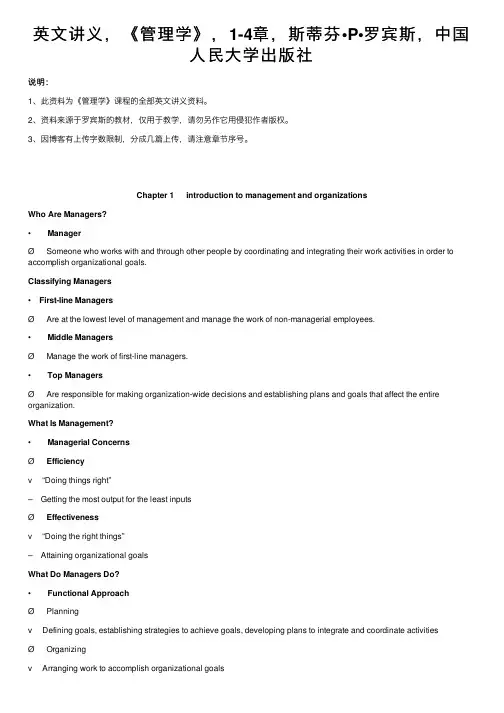
英⽂讲义,《管理学》,1-4章,斯蒂芬•P•罗宾斯,中国⼈民⼤学出版社说明:1、此资料为《管理学》课程的全部英⽂讲义资料。
2、资料来源于罗宾斯的教材,仅⽤于教学,请勿另作它⽤侵犯作者版权。
3、因博客有上传字数限制,分成⼏篇上传,请注意章节序号。
Chapter 1 introduction to management and organizationsWho Are Managers?• ManagerØ Someone who works with and through other people by coordinating and integrating their work activities in order to accomplish organizational goals.Classifying Managers• First-line ManagersØ Are at the lowest level of management and manage the work of non-managerial employees.• Middle ManagersØ Manage the work of first-line managers.• Top ManagersØ Are responsible for making organization-wide decisions and establishing plans and goals that affect the entire organization.What Is Management?• Managerial ConcernsØ Efficiencyv “Doing things right”– Getting the most output for the least inputsØ Effectivenessv “Doing the right things”– Attaining organizational goalsWhat Do Managers Do?• Functional ApproachØ Planningv Defining goals, establishing strategies to achieve goals, developing plans to integrate and coordinate activitiesØ Organizingv Arranging work to accomplish organizational goalsØ Leadingv Working with and through people to accomplish goals.Ø Controllingv Monitoring, comparing, and correcting the work• Management Roles ApproachØ Interpersonal rolesv Figurehead, leader, liaisonØ Informational rolesv Monitor, disseminator, spokespersonØ Decisional rolesv Disturbance handler, resource allocator, negotiator• Skills ApproachØ Technical skillsv Knowledge and proficiency in a specific fieldØ Human skillsv The ability to work well with other peopleØ Conceptual skillsv The ability to think and conceptualize about abstract and complex situations concerning the organization How The Manager’s Job Is Changing• The Increasing Importance of CustomersØ Customers: the reason that organizations existv Managing customer relationships is the responsibility of all managers and employees.v Consistent high quality customer service is essential for survival.• InnovationØ Doing things differently, exploring new territory, and taking risksv Managers should encourage employees to be aware of and act on opportunities for innovation.What Is An Organization?• An Organization DefinedØ A deliberate arrangement of people to accomplish some specific purpose• Common Characteristics of OrganizationsØ Have a distinct purpose (goal)Ø Composed of peopleØ Have a deliberate structureWhy Study Management?• The Value of Studying ManagementØ The universality of managementv Good management is needed in all organizations.Ø The reality of workv Employees either manage or are managed.Ø Rewards and challenges of being a managerv Management offers challenging, exciting and creative opportunities for meaningful and fulfilling work. v Successful managers receive significant monetary rewards for their efforts.Chapter 2 management yesterday and todayHistorical Background of Management• Ancient ManagementØ Egypt (pyramids) and China (Great Wall)Ø Venetians (floating warship assembly lines)• Adam SmithØ Published “The Wealth of Nations” in 1776v Advocated the division of labor (job specialization) to increase the productivity of workers• Industrial RevolutionØ Substituted machine power for human laborØ Created large organizations in need of managementMajor Approaches to Management• Scientific Management• General Administrative Theory• Quantitative Management• Organizational Behavior• Systems Approach• Contingency ApproachScientific Management• Fredrick Winslow TaylorØ The “father” of scientific managementØ Published Principles of Scientific Management (1911)v The theory of scientific management:– Using scientific methods to define the “one best way” for a job to be done• Putting the right person on the job with the correct tools and equipment• Having a standardized method of doing the job• Providing an economic incentive to the worker• Frank and Lillian GilbrethØ Focused on increasing worker productivity through the reduction of wasted motionØ Developed the microchronometer to time worker motions and optimize performance.• How Do Today’s Managers Use Scientific Management?Ø Use time and motion studies to increase productivityØ Hire the best qualified employeesØ Design incentive systems based on outputGeneral Administrative Theorists• Henri FayolØ Believed that the practice of management was distinct from other organizational functionsØ Developed fourteen principles of management that applied to all organizational situations• Max WeberØ Developed a theory of authority based on an ideal type of organization (bureaucracy)v Emphasized rationality, predictability, impersonality, technical competence, and authoritarianism. Quantitative Approach to Management• Quantitative ApproachØ Also called operations research or management scienceØ Evolved from mathematical and statistical methods developed to solve WWII military logistics and quality control problemsØ Focuses on improving managerial decision making by applying:v Statistics, optimization models, information models, and computer simulationsUnderstanding Organizational Behavior• Organizational Behavior (OB)Ø The study of the actions of people at work; people are the most important asset of an organization• Early OB AdvocatesØ Robert OwenØ Hugo MunsterbergØ Mary Parker FollettØ Chester BarnardThe Hawthorne Studies• A series of productivity experiments conducted at Western Electric from 1927 to 1932.• Experimental findingsØ Productivity unexpectedly increased under imposed adverse working conditions.Ø The effect of incentive plans was less than expected.• Research conclusionØ Social norms, group standards and attitudes more strongly influence individual output and work behavior than domonetary incentives.The Systems Approach• System DefinedØ A set of interrelated and interdependent parts arranged in a manner that produces a unified whole.• Basic Types of SystemsØ Closed systemsv Are not influenced by and do not interact with their environment (all system input and output is internal)Ø Open systemsv Dynamically interact to their environments by taking in inputs and transforming them into outputs that are distributed into their environmentsImplications of the Systems Approach• Coordination of the organization’s parts is essential for proper functioning of the entire organization.• Decisions and actions taken in one area of the organization will have an effect in other areas of the organization.• Organizations are not self-contained and, therefore, must adapt to changes in their external environment.The Contingency Approach• Contingency Approach DefinedØ Also sometimes called the situational approach.Ø There is no one universally applicable set of management principles (rules) by which to manage organizations.Ø Organizations are individually different, face different situations (contingency variables), and require different ways of managing.Current Trends and Issues• Globalization• Ethics• Workforce Diversity• Entrepreneurship• E-business• Knowledge Management• Learning Organizations• Quality Management• Globalization• Management in international organizations• Political and cultural challenges of operating in a global market• Ethics• Increased emphasis on ethics education in college curriculums• Increased creation and use of codes of ethics by businesses• Workforce Diversity• Increasing heterogeneity in the workforce• More gender, minority, ethnic, and other forms of diversity in employees• Aging workforce• Older employees who work longer and not retire• The cost of public and private benefits for older workers will increase• Increased demand for products and services related to aging• Entrepreneurship Defined• The process whereby an individual or group of individuals use organized efforts to create value and grow by fulfilling wants and needs through innovation and uniqueness.• Entrepreneurship process• Pursuit of opportunities• Innovation in products, services, or business methods• Desire for continual growth of the organization• E-Business (Electronic Business)• The work preformed by an organization using electronic linkages to its key constituencies• E-commerce: the sales and marketing component of an e-business• Categories of E-Businesses• E-business enhanced organization• E-business enabled organization• Total e-business organization• Knowledge Management• The cultivation of a learning culture where organizational members systematically gather and share knowledge with others in order to achieve better performance.• Learning Organization• An organization that has developed the capacity to continuously learn, adapt, and change.• Quality Management• A philosophy of management driven by continual improvement in the quality of work processes and responding to customer needs and expectations• Inspired by the total quality management (TQM) ideas of Deming and Juran• Quality is not directly related to cost.Chapter 3 organizational culture and the environment : the constraintsThe Manager: Omnipotent or Symbolic?• Omnipotent View of ManagementØ Managers are directly responsible for an organization’s success or failure.Ø The quality of the organization is determined by the quality of its managers.Ø Managers are held most accountablefor an organization’s performanceyet it is difficult to attributegood or poor performancedirectly to their influenceon the organization.• Symbolic View of ManagementØ Much of an organization’s success or failure is due to external forces outside of managers’ control.Ø The ability of managers to affect outcomes is influenced and constrained by external factors.• The economy, customers, governmental policies, competitors, industry conditions,technology, and the actions ofprevious managersØ Managers symbolize control andinfluence through their actionThe Organization’s Culture• Organizational CultureØ A system of shared meanings and common beliefs held by organizational members that determines, in a large degree, how they act towards each other.Ø “The way we do things around here.”v Values, symbols, rituals, myths, and practicesØ Implications:v Culture is a perception.v Culture is shared.v Culture is descriptiveStrong versus Weak Cultures• Strong CulturesØ Are cultures in which key values are deeply held and widely held.Ø Have a strong influence on organizational members.• Factors Influencing the Strength of CultureØ Size of the organizationØ Age of the organizationØ Rate of employee turnoverØ Strength of the original cultureØ Clarity of cultural values and beliefsBenefits of a Strong Culture• Creates a stronger employee commitment to the organization.• Aids in the recruitment and socialization of new employees.• Fosters higher organizationalperformance by instilling andpromoting employee initiativeOrganizational Culture• Sources of Organizational CultureØ The organization’s founderv Vision and missionØ Past practices of the organizationv The way things have been doneØ The behavior of top management• Continuation of the Organizational CultureØ Recruitment of like-minded employees who “fit.”Ø Socialization of new employees to help them adapt to the cultureHow Employees Learn Culture• StoriesØ Narratives of significant events or actions of people that convey the spirit of the organization • RitualsØ Repetitive sequences of activities that express and reinforce the values of the organization • Material SymbolsØ Physical assets distinguishing the organization• LanguageØ Acronyms and jargon of terms, phrases, and word meanings specific to an organization How Culture Affects Managers• Cultural Constraints on ManagersØ Whatever managerial actions the organization recognizes as proper or improper on its behalf Ø Whatever organizational activities the organization values and encouragesØ The overall strength or weakness of the organizational cultureSimple rule for getting ahead in an organization:Find out what the organization rewards and do those things.Organization Culture Issues• Creating an Ethical CultureØ High in risk toleranceØ Low to moderate aggressivenessØ Focus on means as well as outcomes• Creating an Innovative CultureØ Challenge and involvementØ FreedomØ Trust and opennessØ Idea timeØ Playfulness/humorØ Conflict resolutionØ DebatesØ Risk-taking• Creating a Customer-Responsive CultureØ Hiring the right type of employees (ones with a strong interest in serving customers)Ø Having few rigid rules, procedures, and regulationsØ Using widespread empowerment of employeesØ Having good listening skills in relating to customers’ messagesØ Providing role clarity to employees to reduce ambiguity and conflict and increase job satisfactionØ Having conscientious, caring employees willing to take initiativeSpirituality and Organizational Culture• Workplace SpiritualityØ The recognition that people have an inner life that nourishes and is nourished by meaningful work that takes place in the context of community.• Characteristics of a Spiritual OrganizationØ Strong sense of purposeØ Focus on individual developmentØ Trust and opennessØ Employee empowermentØ Toleration of employees’ expressionBenefits of Spirituality• Improved employee productivity• Reduction of employee turnover• Stronger organizational performance• Increased creativity• Increased employee satisfaction• Increased team performance• Increased organizational performanceDefining the External Environment• External EnvironmentØ The forces and institutions outside the organization that potentially can affect the organization’s performance.• Components of the External EnvironmentØ Specific environment: external forces that have a direct and immediate impact on the organization.Ø General environment: broad economic, socio-cultural, political/legal, demographic, technological, and global conditions that may affect the organization.How the Environment Affects Managers• Environmental UncertaintyØ The extent to which managers have knowledge of and are able to predict change their organization’s external environment is affected by:v Complexity of the environment: the number of components in an organization’s external environment.v Degree of change in environmental components: how dynamic or stable the external environment is. Stakeholder Relationships• StakeholdersØ Any constituencies in the organization’s external environment that are affected by the organization’s decisions and actions• Why Manage Stakeholder Relationships?Ø It can lead to improved organizational performance.Ø It’s the “right” thing to do given the interdependence of the organization and its external stakeholders. Managing Stakeholder Relationships1. Identify the organization’s external stakeholders.2. Determine the particular interests and concerns of the external stakeholders.3. Decide how critical each external stakeholder is to the organization.4. Determine how to manage each individual external stakeholder relationship.Chapter 4 managing in a global environmentManaging in a Global Environment• ChallengesØ Coping with the sudden appearance of new competitorsØ Acknowledging cultural, political, and economic differencesØ Dealing with increased uncertainty, fear, and anxietyØ Adapting to changes in the global environmentØ Avoiding parochialismAdopting a Global Perspective• Ethnocentric AttitudeØ The parochialistic belief that the best work approaches and practices are those of the home country.• Polycentric AttitudeØ The view that the managers in the host country know the best work approaches and practices for running their business.• Geocentric AttitudeØ A world-oriented view that focuses on using the best approaches and people from around the globe.Regional Trading Agreements• The European Union (EU)Ø A unified economic and trade entityv Belgium, Denmark, France, Greece, Ireland, Italy, Luxembourg, the Netherlands, Portugal, Spain, the United Kingdom, Germany, Austria, Finland, and SwedenØ Economic and monetary union (Euro)• North American Free Trade Agreement (NAFTA)Ø Eliminated barriers to free trade (tariffs, import licensing requirements, and customs user fees)v United States, Canada, and Mexico• Free Trade Area of the Americas• Southern Cone Common Market (Mercosur)• Association of Southeast Asian Nations (ASEAN)Ø Trading alliance of 10 Southeast Asian nations• African UnionThe World Trade Organization (WTO)• Evolved from the General Agreement on Tariffs and Trade (GATT) in 1995.• Functions as the only global organization dealing with the rules of trade among nations.• Has 145 member nations.• Monitors and promotes world trade.Different Types of Global Organizations• Multinational Corporation (MNC)Ø A firm which maintains operations in multiple countries but manages the operations from a base in the home country.• Transnational Corporation (TNC)Ø A firm that maintains operations in several countries but decentralizes management to the local country.• Borderless OrganizationØ A firm that has eliminated structural divisions that impose artificial geographic barriers and is organized along business lines.How Organizations Go Global• Three Stages of GlobalizationØ Stage Iv Exporting products for sale overseas and importing products from overseas to sell in the home country.Ø Stage IIv Committing to directly sell home-country products in overseas markets or contracting for products to be manufactured overseas and sold in the home country.Ø Stage IIIv Licensing manufacturing and franchising services to foreign firms to use the brand name, technology, or product specifications developed by the firm.Other Forms of Globalization• Strategic AlliancesØ Partnerships between and organization and a foreign company in which both share resources and knowledge in developing new products or building new production facilities.• Joint VentureØ A specific type of strategic alliance in which the partners agree to form a separate, independent organization for some business purpose.Managing in A Global Environment• The Legal EnvironmentØ Stability or instability of legal and political systemsv Legal procedures are established and followedv Fair and honest elections held on a regular basisØ Differences in the laws of various nationsv Effects on business activitiesv Effects on delivery of products and servicesThe Economic Environment• Economic SystemsØ Market economyv An economy in which resources are primarily owned and controlled by the private sector.Ø Command economyv An economy in which all economic decisions are planned by a central government.• Monetary and Financial FactorsØ Currency exchange ratesØ Inflation ratesØ Diverse tax policiesThe Cultural Environment• National CultureØ Is the values and attitudes shared by individuals from a specific country that shape their behavior and their beliefs about what is important.Ø May have more influence on an organization than the organization culture.Hofstede’s Framework for Assessing Cultures• Individualism versus Collectivism• Power Distance• Uncertainty Avoidance• Quantity versus Quality of Life• Long-term versus Short-term OrientationØ Individualism: the degree to which people in a country prefer to act as individuals.Ø Collectivism: a social framework in whichThe GLOBE (Global Leadership and Organizational Behavior Effectiveness) Framework for Assessing Cultures• Assertiveness• Future orientation• Gender differentiation • Uncertainty avoidance • Power distance• Individualism/collectivism • In-group collectivism • Performance orientation • Humane orientation。
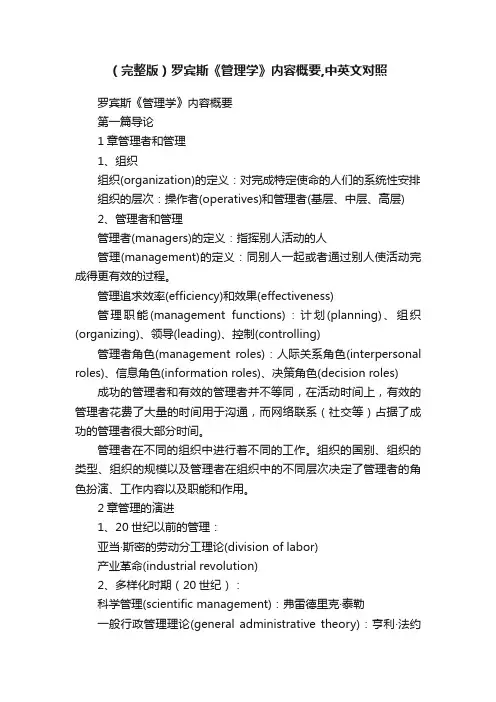
(完整版)罗宾斯《管理学》内容概要,中英文对照罗宾斯《管理学》内容概要第一篇导论1章管理者和管理1、组织组织(organization)的定义:对完成特定使命的人们的系统性安排组织的层次:操作者(operatives)和管理者(基层、中层、高层)2、管理者和管理管理者(managers)的定义:指挥别人活动的人管理(management)的定义:同别人一起或者通过别人使活动完成得更有效的过程。
管理追求效率(efficiency)和效果(effectiveness)管理职能(management functions):计划(planning)、组织(organizing)、领导(leading)、控制(controlling)管理者角色(management roles):人际关系角色(interpersonal roles)、信息角色(information roles)、决策角色(decision roles) 成功的管理者和有效的管理者并不等同,在活动时间上,有效的管理者花费了大量的时间用于沟通,而网络联系(社交等)占据了成功的管理者很大部分时间。
管理者在不同的组织中进行着不同的工作。
组织的国别、组织的类型、组织的规模以及管理者在组织中的不同层次决定了管理者的角色扮演、工作内容以及职能和作用。
2章管理的演进1、20世纪以前的管理:亚当·斯密的劳动分工理论(division of labor)产业革命(industrial revolution)2、多样化时期(20世纪):科学管理(scientific management):弗雷德里克·泰勒一般行政管理理论(general administrative theory):亨利·法约尔(principles of management)、马克斯·韦伯(bureaucracy) 人力资源方法(human resources approach):权威的接受观点(acceptance view of authority),霍桑研究,人际关系运动(卡内基、马斯洛),行为科学理论家(behavioral science theorists) 定量方法(quantitative approach)3、近年来的趋势(20世纪后期):趋向一体化过程方法(process approach)系统方法(systems approach):封闭系统和开放系统(closed systems)权变方法(contingency approach):一般性的权变变量包括组织规模、任务技术的例常性、环境的不确定性、个人差异4、当前的趋势和问题(21世纪):变化中的管理实践全球化(globalization)工作人员多样化(work force diversity)道德(morality)激励创新(innovations)和变革(changes)全面质量管理(total quality management, TQM):由顾客需要和期望驱动的管理哲学授权(delegation)工作人员的两极化(bi-modal work force)3章组织文化与环境:管理的约束力量1、组织组织文化(organizational culture)被用来指共有的价值体系。
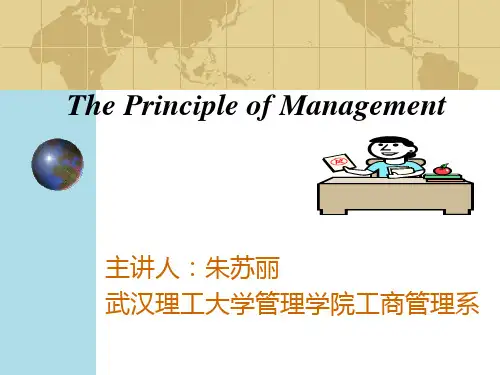
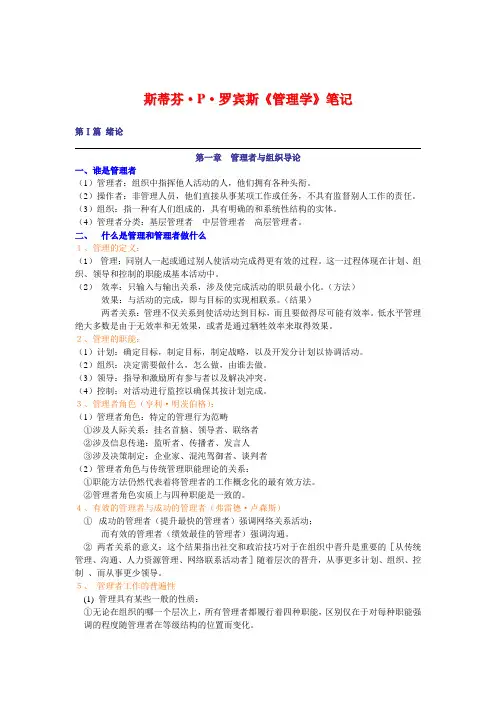
斯蒂芬·P·罗宾斯《管理学》笔记第Ⅰ篇绪论第一章管理者与组织导论一、谁是管理者(1)管理者:组织中指挥他人活动的人,他们拥有各种头衔。
(2)操作者:非管理人员,他们直接从事某项工作或任务,不具有监督别人工作的责任。
(3)组织:指一种有人们组成的,具有明确的和系统性结构的实体。
(4)管理者分类:基层管理者中层管理者高层管理者。
二、什么是管理和管理者做什么1、管理的定义:(1)管理:同别人一起或通过别人使活动完成得更有效的过程。
这一过程体现在计划、组织、领导和控制的职能成基本活动中。
(2)效率:只输入与输出关系,涉及使完成活动的职员最小化。
(方法)效果:与活动的完成,即与目标的实现相联系。
(结果)两者关系:管理不仅关系到使活动达到目标,而且要做得尽可能有效率。
低水平管理绝大多数是由于无效率和无效果,或者是通过牺牲效率来取得效果。
2、管理的职能:(1)计划:确定目标,制定目标,制定战略,以及开发分计划以协调活动。
(2)组织:决定需要做什么,怎么做,由谁去做。
(3)领导:指导和激励所有参与者以及解决冲突。
(4)控制:对活动进行监控以确保其按计划完成。
3、管理者角色(亨利·明茨伯格):(1)管理者角色:特定的管理行为范畴①涉及人际关系:挂名首脑、领导者、联络者②涉及信息传递:监听者、传播者、发言人③涉及决策制定:企业家、混沌驾御者、谈判者(2)管理者角色与传统管理职能理论的关系:①职能方法仍然代表着将管理者的工作概念化的最有效方法。
②管理者角色实质上与四种职能是一致的。
4、有效的管理者与成功的管理者(弗雷德·卢森斯)①成功的管理者(提升最快的管理者)强调网络关系活动;而有效的管理者(绩效最佳的管理者)强调沟通。
②两者关系的意义:这个结果指出社交和政治技巧对于在组织中晋升是重要的[从传统管理、沟通、人力资源管理、网络联系活动者]随着层次的晋升,从事更多计划、组织、控制、而从事更少领导。
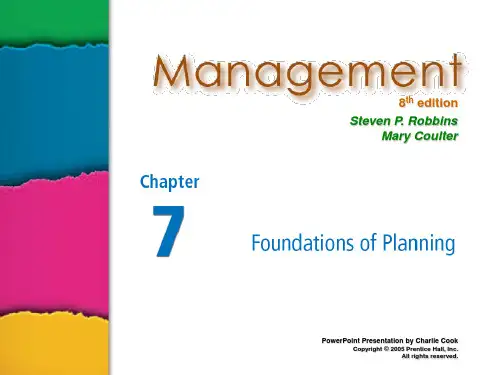
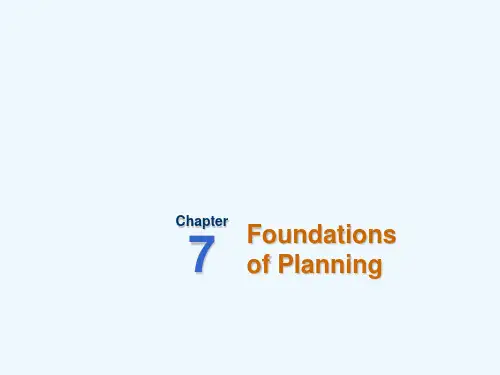
罗宾斯管理学第七版讲义1. 管理学的起源和演变管理学是研究管理活动的学科,它涉及组织、计划、领导和控制等方面的原则和实践。
管理学的起源可以追溯到古代文明时期,但它在20世纪才得到了进一步的发展和完善。
1.1 古代管理思想古代的管理思想主要集中在统治者和政府的组织和管理上。
例如,古罗马帝国的管理模式强调军队、政府和治理的组织,以确保帝国的运作。
古中国的管理思想则注重以德治国、以法治国、以行治国等。
1.2 工业革命前的管理学工业革命前的管理学主要集中在手工业和农业领域。
亚当·斯密和大卫·李维都对劳动力的分工和农业生产的效率提出了理论。
他们的思想在工业革命后得到了广泛应用。
1.3 科学管理运动从20世纪初开始,管理学进入了科学管理运动的时期。
弗雷德里克·泰勒和亨利·福特等人的科学方法和精细分工理论被广泛应用于工业生产中。
他们的研究建立了管理学的基本原理,如时间与运动研究、标准化工作程序和奖励制度等。
2. 管理学的基本原理管理学的基本原理是指领导者在组织中进行管理时应该遵循的原则和方法。
以下是一些管理学的基本原理:2.1 计划计划是管理的起点。
领导者需要制定清晰的目标和相应的行动计划,以保证工作的顺利进行和目标的实现。
2.2 组织组织是指将各项工作合理地分配给不同的个体和部门,以实现整体目标。
组织需要考虑到工作的流程、岗位的职责和权责的分配等方面。
2.3 领导领导是指通过激励、指导和激发员工的潜力来实现组织目标。
领导者需要具备良好的沟通和协调能力,以及处理冲突和解决问题的能力。
2.4 控制控制是指监督工作的进展和结果,以确保目标的达成。
控制过程涉及评估绩效、采取纠正措施和调整计划等方面。
3. 管理学的应用领域管理学的原理和方法可以应用于各个组织和领域。
以下是一些管理学的应用领域的示例:3.1 经营管理经营管理是指企业或组织的管理和运营。
它涉及市场营销、生产运作、财务管理和人力资源管理等方面的工作。
sevenFoundations of Planning1. INTRODUCTION.Planning is one of the four functions of management. The basics of planning are presented in this chapter. The text discusses what planning is, why managers plan, how they plan, and provides some contemporary issues related to planning.2. WHAT IS PLANNING?Planning involves defining the organization’s goals, establishing an overall strategy for achieving these goals, and developing a comprehensive set of plans to integrate and coordinate organizational work. The term planning as used in this chapter refers to formal planning.3. WHY DO MANAGERS PLAN?A. Purposes of Planning.Planning is important and serves many significant purposes.1. Planning gives direction to the organization.2. Planning reduces the impact of change.3. Planning establishes a coordinated effort.4. Planning reduces uncertainty.5. Planning reduces overlapping and wasteful activities.6. Planning establishes objectives or standards that are used incontrolling.B. Planning and PerformanceResearch has shown we cannot assume organizations with formalplanning processes always outperform those organizations that don’thave formal planning processes.1. Generally speaking, however, formal planning is associated withpositive financial results.C. The quality of the planning process and appropriate implementationprobably contribute more to high performance than does the extent ofplanning.D. When formal planning has been shown not to lead to higherperformance, the environment is usually the reason.4. HOW DO MANAGERS PLAN?Planning is often called the primary management function because it establishes the basis for all other functions. Planning involves two important elements: goals and plans.A. The Role of Goals and Plans in Planning.1. Goals—desired outcomes for individuals, groups, or entireorganizations.2. Goals are objectives—the two terms are used interchangeably.3. Types of goals.a. Financial performance versus strategic goals (seeExhibit7.1for a list of both financial and strategicgoals from well-known U.S. corporations).b. Stated versus Real.1) Stated goals are official statements of what anorganization says, and what it wants its variousstakeholders to believe, its goals are.2) Real goals are those that an organizationactually purses.4. Types of Plans.Plans can be described by their breadth, time frame, specificity,and frequency of use. (See Exhibit7.2)a. Breadth: strategic versus operational plans.Strategicplans (longer-term) are those that are organization wide,establish overall objectives, and position an organizationin terms of its environment. Operational plans (shorter-term) are plans that specify details on how overallobjectives are to be achieved.b. Time frame: short-term versus long-term plans.Short-term plans are plans that cover one year or less. Long-term plans are those that extend beyond three years.c. Specificity: specific versus directional plans.Specificplans are those that are clearly defined and leave noroom for interpretation. Directional plans are flexibleplans that set out general guidelines. (See Exhibit7.3for illustrations on how specific and directional planningdiffers.)d. Frequency of use: single-use versus standing plans.Asingle-use plan is a one-time plan that is specificallydesigned to meet the needs of a unique situation and iscreated in response to nonprogrammed decisions thatmanagers make. Standing plans are those ongoing plansthat provide guidance for activities repeatedly performedand that are created in response to programmeddecisions that managers make.5. ESTABLISHING GOALS AND DEVELOPING PLANS.A. Approaches to Establishing Goals.Goals can be established through a process of traditional goal setting orthrough management by objectives1. Traditional goal setting is defined as the process whereby goalsare set at the top of the organization and then broken down intosub goals for each level in an organization.a.Top managers are assumed to know what’s best becausethey see the “big picture.”b. These goals are also often largely nonoperational.c. Specificity is achieved as each manager applies his orher own set of interpretations and biases.d. However, what often results is that objectives loseclarity and unity as they move from top to bottom. (SeeExhibit7.4)e. When the hierarchy of objectives is clearly defined, itforms an integrated means-end chain in which higher-level objectives are linked to lower-level objectives.These lower-level objectives serve as the means for theaccomplishment of the higher-level objectives. And thegoals at the lower levels (means) must be achieved inorder to reach the goals at the next level (ends).2. Management by objectives (MBO)is defined as a system inwhich specific performance goals are jointly determined byemployees and their managers, progress toward accomplishingthese goals is periodically reviewed, and rewards are allocatedon the basis of this progress.a. MBO was first described by Peter Drucker and consistsof four elements:1. Goal specificity2. Participative decision-making3. Explicit time period4. Performance feedbackb. MBO makes objectives operational through the processby which they cascade down through the organization.c. Exhibit7.5 lists the steps in a typical MBO program.d. Does MBO work? Studies of actual MBO programsconfirm that MBO can increase employee performanceand organizational productivity. However, top-management commitment and involvement areimportant contributions to the success of an MBOprogram.3. Whether an organization uses a more traditional (top tobottom) approach to establishing objectives, uses someform of MBO, or has it own approach, managers mustdefine objectives before they can effectively andefficiently complete other planning activities.B. Characteristics of Well-Designed Goals (see Exhibit7.6).1 Written in terms of outcomes2. Measurable and quantifiable3. Clear as to a time frame4. Challenging but attainable5. Written down6. Communicated to all organizational membersC. Steps in Goals Setting—Five Steps.1. Review the organization’s mission.Goals should reflect what the mission statement says.2. Evaluate available resources.3. Determine individually, or with input from others, the goals.4. Write down the goals and communicate them to all who need toknow.5. Review results and whether goals are being met.D. Developing Plans.The process of developing plans is influenced by three contingencyfactors and by the planning approach followed.1. Contingency Factors in Planning.a. Manage r’s level in the organization. (See Exhibit7.7)Operational planning usually dominates the planningactivities of lower-level managers. As managers moveup through the levels of the organization, their planningbecomes more strategy oriented.b. Degree of environmental uncertainty. The greater theenvironmental uncertainty, the more plans should bedirectional and emphasis placed on the short term.1) When uncertainty is high, plans should bespecific, but flexible.2) Managers must be prepared to rework andamend plans, or even to abandon their plans.c. Length of Future Commitments.1) Commitment concept means that plans shouldextend far enough to meet those commitmentsmade when the plans were developed.2) Planning for too long or for too short a timeperiod is inefficient and ineffective.2. Approaches to Planning.a. Traditional Approach—planning was done entirely bytop-level managers who were often assisted by a formalplanning department.b. Organizational Member Involvement—plans aren’thanded down from one level to the next, but aredeveloped at the various levels to meet specific needs. 6. CONTEMPORARY ISSUES IN PLANNING.This section looks at criticisms of planning and how managers can plan effectively in dynamic environments.A. Criticisms of Planning.Although planning is an important and popular managerial function, fivemajor arguments have been directed against planning.1. Planning may create rigidity.Formal planning may “lock” anorganization into specific goals and specific timetables that wereestablished under certain environmental conditions. If theenvironment changes, managers may believe they’re locked intothe current plans.2. Plans can’t be developed for a dynamic environment. Managingunder chaotic environmental conditions requires flexibility, andthat may mean not being tied to formal plans.3. Formal plans can’t replace intuition and creativity. The formalplanning process may emphasize the mechanics and routines ofplanning and ignore important aspects.4. Planning focu ses managers’ attention on today’s competitionnot on tomorrow’s survival. Formal planning has a tendency tomake managers focus on today’s realities, not on tomorrow’spossibilities.5. Formal planning reinforces success, which may lead to failure.Because the "plans" have led to success, there may be areluctance on the part of managers to change or discardpreviously successful plans. "If it ain’t broke, why fix it?"B. Effective Planning in Dynamic Environments. The external environmentis constantly changing.1. Managers want to develop plans that are specific, but flexible.2. Managers must recognize that planning is an ongoing process,and they should be willing to change directions if environmentalconditions warrant.3. Flexibility is particularly important.4. Managers must stay alert to environmental changes that couldimpact the effective implementation of plans and make changesas needed.1. Will planning become more or less important to managers in the future? Why?Planning will probably become more important to managers in the future because of the uncertainty present in the environment. There are so many changes taking place in both the general and specific environments of organizations, and many of these changes are taking place rapidly. Planning helps managers cope with the uncertainties by forcing managers to look ahead, anticipate change, consider the impact of the change, and develop appropriate responses.2. If planning is so crucial, why do some managers choose not to do it? Whatwould you tell these managers?Managers may choose not to do it because they don’t know how or they claim they don’t have the time to do it. Others may say that it’s a waste of time, that the future is going to happen whether or not they plan. But, all of these reasons do not discount the importance of planning. Every manager should engage in planning.3. Explain how planning involves decisions today that will have an impact later.Decisions that managers make as they plan will influence how activities are organized, how employees are managed, and what controlling is performed. So even as managers look to the future by planning, the decisions they’re making as they plan will have an effect on the other managerial activities.4. How might planning in a not-for-profit organization such as the AmericanCancer Society differ from planning in a for-profit organization such as Coca-Cola?The process of planning itself won’t differ, but the content of the plans will differ. The types of objectives that are established and the plans that are formulated will be different because a not-for-profit organization isn’t focused on profit objectives like the for-profit organization.。